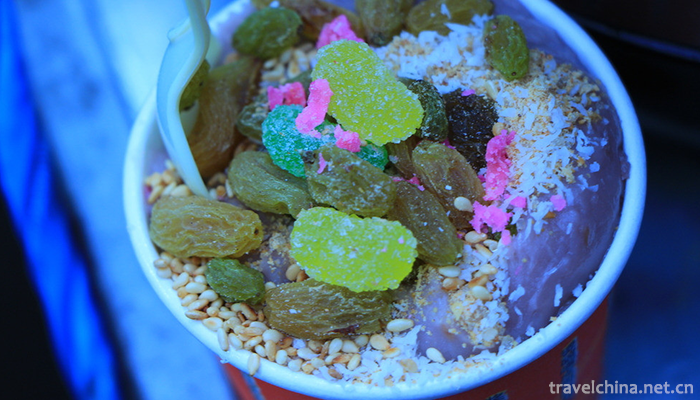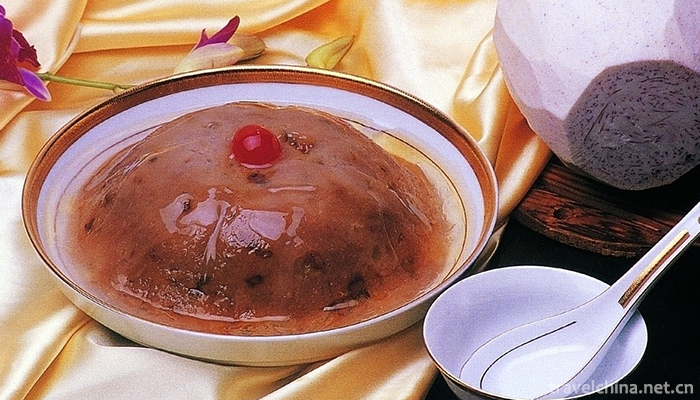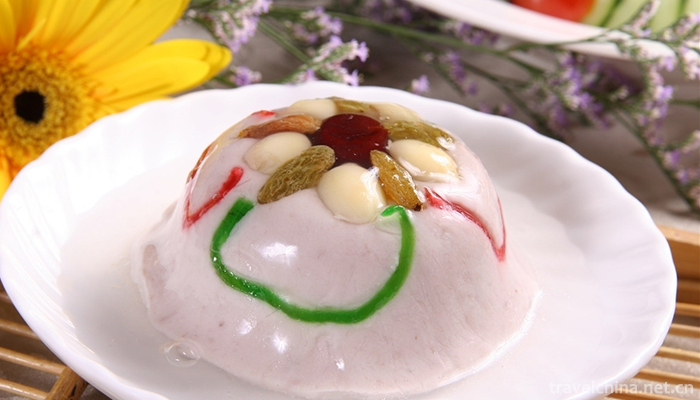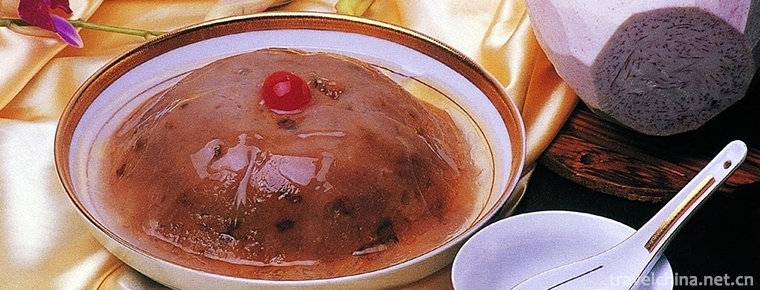Eight treasures taro
Eight treasures taro
Babao taro paste is one of the local traditional sweet spots in Fujian cuisine. This dish is delicate, soft, sweet and delicious. It looks like a cold dish but burns its mouth. It has a unique flavor. It is often served at feasts on auspicious occasions.
Characteristics of dishes
This dish is delicate, soft, sweet and delicious. It looks like a cold dish, but it burns its mouth. It has a unique flavor. There are many such dishes at feasts.
Allusion
It's famous for an interesting story. In the seventeenth year of Qingdaoguang (1839 A.D.), Lin Zexu, the imperial minister, went to Guangzhou to ban smoking. In order to ridicule Chinese officials, consuls from Britain and the United States specially prepared western cold dishes in an attempt to make Lin Zexu look ugly when eating ice cream. Afterwards, Lin Zexu set up a grand feast of "Respect". After a few cold dishes, a dish of dark gray and shiny, dark brown and smooth, without steaming, is served as a cold dish. A foreign consul spooned it into his mouth, burning his eyes straight, and the other guests were shocked. At this time, Lin Zexu carelessly introduced that this is a famous dish in Fujian Province of China called taro paste.
Material Science
Taro 500g, bean paste 100g, decorative preserves (sugar lotus seeds, red and green silk, raisins, green plum, etc.) appropriate amount.
Seasoning:
(A) Two spoons of sugar and two spoons of salad oil;
(B) Three spoons of sugar, one cup of hot water;
(C) Half a spoonful of dry starch and half a spoonful of water.
practice
1. Peel and slice taro, wash it, wrap it in microwave film (do not drip dry). Heat it over high heat for 8 minutes until chopsticks can penetrate. After taking it out, press it into mud shape with knife back and add seasoning (A) and mix well.
(2) Take a medium bowl, put a layer of salad oil on the inside, then arrange the decorative preserves into a circle, fill in half of the taro paste, put the bean paste in the center, then fill the remaining taro paste with flattening, cover with microwave film, heat for 3 minutes, take out and buckle on the plate.
(3) Put seasoning (B) into the container, heat it for 2.5 minutes at high temperature, add seasoning (C) and mix well. Continue to heat for 20 seconds and take it out. Sprinkle it on taro paste while it is hot.
To make this dish, first peel Fuding taro, wash it and cut it into pieces. Steam it in a drawer for about an hour. Remove it and press it into mud with a knife board. Take care to pick out the thick ribs at this time. Then put the taro paste in a bowl, add sugar and cooked lard, mix well with clean water, smooth it, steam it in the drawer for 1 hour, and take it out. According to each person's taste, you can also put some bean paste stuffing in taro paste appropriately, the flavor is better. After serving, the taro paste is sprinkled with eight ingredients, such as pulp, jujube paste, osmanthus fragrans, peanut kernels, longan, honey jujube, green and red silk, which are colorful and attractive. Babao taro paste got its name from this. The local Fuding taro is of good quality and rich in resources, and the common folk people can make this dessert by themselves.
Nutritive value
The nutritional value of taro is very high. The starch content in tuber is 70%. It can be used as both food and vegetable. It is a good tonic for both old and young. It is a valuable vegetarian food in autumn. Taro is also rich in protein, calcium, phosphorus, iron, potassium, magnesium, sodium, carotene, nicotinic acid, vitamin C, vitamin B1, vitamin B2, saponins and other components. According to traditional Chinese medicine, taro is sweet, spicy and flat, enters the intestine and stomach. It has the functions of benefiting stomach, widening intestine, relieving constipation, tonifying liver and kidney, and adding lean marrow.




-
1.Baishishan Scenic Area Baoding City Hebei Province
Baishishan Scenic Area, also known as Baishishan National Geological Park, is called "Xiaohuangshan" because its scenery resembles the Huangshan Mountain in Anhui Province.
Time 2018-11-24 -
2.Bogda Ula Festival
The sacrifice of Bogdahura (Shenshan) is one of the earliest forms of Mongolian creative culture in China. It is the product of national culture, which is formed by historical accumulation and plurali
Time 2019-04-04 -
3.dongjing music
Dongjing music is a very ancient traditional instrumental music, which originated in Sichuan Province in the Song Dynasty and is now popular in Sichuan Province
Time 2019-04-28 -
4.Kazakh medicine
Since the pre-Qin Dynasty, the Kazakh people have multiplied and lived in the vast grasslands and some agricultural areas in Northwest China. They have accumulated rich medical experience in productio
Time 2019-05-02 -
5.Gino Encouragement
Great encouragement, traditional dance in Jinghong City, Yunnan Province, is one of the national intangible cultural heritage.
Time 2019-05-05 -
6.Construction Techniques of Jingdezhen Traditional Porcelain Kiln Workshop
Jingdezhen traditional porcelain kiln workshop building skills, Jiangxi Province Jingdezhen local traditional ceramic industry building and building skills, one of the national intangible cultural her
Time 2019-05-08 -
7.Lusheng Dance of Lahu Nationality
Hulusheng dance is a representative of the Lahu nationality. It mainly spreads in busy Nuo Township, Mengmeng Township, Dawen Township, Mengku Township and other Lahu villages in Shuangjiang
Time 2019-05-10 -
8.Match show
Sai opera is an ancient opera which has been spread in Shanxi, Hebei, Inner Mongolia and Shaanxi. It is a traditional literary form with strong local characteristics of frontier fortress. Sai opera wa
Time 2019-06-12 -
9.Shuizu Duanwu Jie
The aquarium duanjie is called "borrowing duanjie" in the language of water. "Duan" means "the first year of life" or "New Year", "borrow" means "
Time 2019-06-16 -
10.Zhongshan Salt Water Song
Salt water song is a form of expression of Guangdong local folk songs, which is mainly spread among farmers and fishermen in the coastal and river network areas of Zhongshan, Panyu, Zhuhai and South C
Time 2019-08-03 -
11.Beijing Institute Of Graphic Communication
Beijing Printing College is a full-time general higher education institution established by the Beijing Municipal People's Government and the former General Administration of Press and Publication. Th
Time 2019-09-22 -
12.Meishan mineral resources
There are 25 kinds of minerals in Meishan, mainly including coal, natural gas, iron, copper, lead, zinc, manganese, placer gold, glauberite, gypsum, bentonite, phosphorus, dolomite, cement limestone, magnesite, granite for facing, vein quartz, crystal, quartz sandstone,
Time 2020-12-18